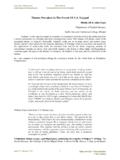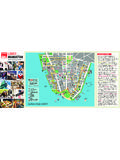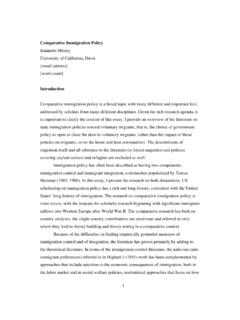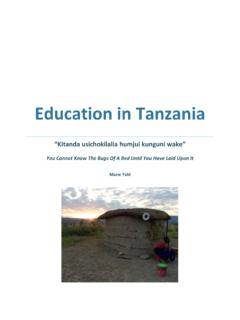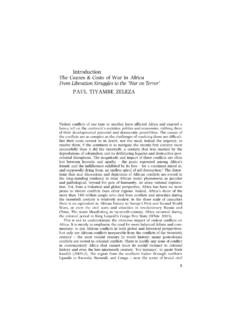Transcription of Valmont Layne - Seagull
1 THESOUNDARCHIVESATTHEDISTRICTSIXMUSEUM:A WORKINPROGRESSV almont LayneSouth Africa is an anomaly among developing countries. It is botha developed country with good infrastructure and also a country withhuge social and economic problems. There is a wide gulf betweenrecipients of development aid on the one hand and skilled profes-sionals on the other. In this assumption lie both the challenges andopportunities for audiovisual preservation. In itemizing the issues,challenges, hurdles and obstacles, my chosen keywords are institu-tional growth, consciousness and expertise.
2 The District Six Museum developed almost without evidentdesign since its conception at a conference in 1988. Yet the soundarchives, a new project conceived in 1997, had the luxury of beingmodelled on ethnographic and public sound archives in the USA andelsewhere. The key scholarly disciplines underpinning its work areHistory, Fine Arts, Social Science and need to build an appropriate archival model for this museum-based sound archives. There are a number of considerations. Themuseum has had a profound effect on heritage work.
3 Our museum isa young institution and is in the grip of what some call the Foundersyndrome . It has a very active board of trustees. It is still an institu-tional baby being weaned by community-based activists, politiciansand professional academics. In some cases, there is a direct political,emotional or professional interest in the work of the museum. Thiscreates a wonderful non-bureaucratic atmosphere. But it also meansArchives for the Future184that as we grow in our preservation capacities we will have to nego-t iate these realities.
4 Another challenge is to develop support structures for re s e a rc h -based audiovisual archives. We need to raise consciousness about thevalue of not only what we have but also what we do. In general, thereis a need to develop expertise in areas such as preservation and doc-u m e n t a t i o the other hand, there are opportunities. The District SixMuseum provides an object model for other community-based initia-tives around the country. I believe we have an opportunity to use themuseum s success to champion the cause of audiovisual preservationwith fraternal institutions in our region.
5 Called the Coon Carnival, the end-of-year event was a time for dancing in thestreets, with various troops competing for trophies and the public residentsand tourists alike having a whale of a time. The streets of the old District wereturned into rivers of prancing participants, all dressed in their colourful cos-tumes. District Six became (more) alive on these occasions. The District Six Museum185I would like to share some of the vision, work in preparation andsome of the difficulties we anticipate as we start building a soundarchives, an exciting new wing of the District Six Museum.
6 THESOUNDARCHIVESASAMEMORYBOOTHIn 1994, the District Six Museum Foundation opened a smallexhibition named Streets:Retracing District exhibition was aworking project for the Foundation. One of its essential features was amap on which ex-residents are invited to mark places of remem-brance: home, neighbourhood and public space. As Curator PeggyDelport described:Its form is by design interactive, in that the formal bound-aries a re open to the inclusion of its audience in the pro c e s sPhotographs:Cloete BreytenbachArchives for the Future186of visual cons t r u ction.
7 [and most importantly] it containsthe present-day cues and reconstructions of everyday exhibition attempts to find an interpretative vehicle appro-priate to the climate of transition and remembrance in South basic museological premise, then, is an invitation to ex-residentsand those who knew the District to remember and, through remem-bering, to collaborate in the creation of public memory about theplace and its significance. Moreover, as the exhibition captured the public imagination, ex-residents flooded the organizers with memorabilia from the District:family photographs, bottles, toys, even items of furniture and , we were not ready for this influx of museum objects.
8 Evenso, accepting the deposit had to be part of the spirit of accepting thepositive community response with Streets, the process was key. The depositing of objects is a by-product of that process. Memory is the core organising principle inthe collection and the key element in the display of objects and dio-ramas. We have not yet imagined or anticipated other uses for theseobjects. For example, we may find that depositors place meanings onobjects that the museum does not yet have the capacity to documentor , the Streetsexhibition space has also been describedas evocative.
9 It promotes the notion that public memory must be sub-ject to debate and the notion that citizens may participate in thatdebate. Now, the problem arises: Should the exhibition become the coreof a new museum? If so, how does the museum collect , dissect andreorganize the memory-laden objects it exhibits? How, in fact, doesthe museum arrest the engaging interactions that happen every timean ex-resident walks in and recognizes the Hanover Street sign, or theimage of the fish market or remembers the Globe Gang, Cissie Gool sfiery speeches on the Grand Parade, diba dance with the Merry Macksor New Year s Eve with the nagtroupe?
10 Or what about ex-residents whocarry more painful memories of loss, of domestic abuse, of poverty, ofaspirations to live in the suburbs? Street scene in District SixCorner of Hanover and Windsor StreetsDe Villiers Street, District SixDistrict Six after the removalsHanover Street, District SixAll photographs courtesythe District Six for the Future188 The Streetsexhibition, in the words of Sandra Prosalendis, itsProject Dire c t o r, needed to be a sieve to capture memories generatedin the exhibition space for posterity.
